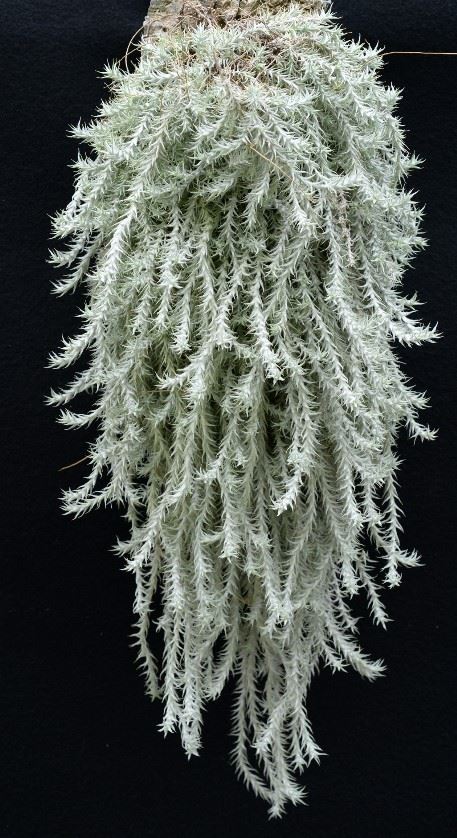Tillandsia stellifera
Click thumbnails for full size, scaled to a new window.
Tillandsia stellifera



| Rob Bower 01/21 |
Eric Gouda 02/21 Utrecht, Netherlands |
Rob Bower ... "A bit of a gem - stellifera. I have 3 and they're all flowering but the first in line decided to abort the spike after sitting there for well over a month."
Bob Hudson ... "That is one I cannot Grow."
Dale Dixon ... "What conditions are you giving yours?"
Rob Bower ... "Standard tectorum 4-5 hrs direct sunlight and the remainder just bright light. Fert - not as often as I should but every few months. They all got a bit hot and dry before the rains came but thatís probably good for those types?"
Eric Gouda ... "Great you flowered it. There are some different types, but the smaller ones do not like to flower for us. For example the clump (nearly 1 m tall) below at Peter Bak's nursery grows like hell, but never flowers."
Tillandsia stellifera L. Hrom., Die Brom. Sonderheft 5: 62-6. 2005.
A T. tectorum E. Morren caulibus perelongatis, foliis perbrevibus et inflorescentia simplici differt.
Typus: Peru, Ancash, Prov. Huari, upper reaches of Rio Puccha, southeast of the city Huari, 3000 m s. m., 04.08.1978, H. & L. Hromadnik HR 4218 (holo USM, iso WU).
Paratypus: Peru, Ancash: San Marcos, 2800 m, F. Fuchs s. n. (WU, Inv.-Nr. 3771); km 35 Chavin-Huari, 2700 m, O. Irrnsdorfer s. n. (WU, Inv. -Nr. 3770).
Plant very long caulescent, growing saxicolous in dense clusters or prostrate mats, stems branching, to 50 cm long, shoots 8-25 mm in diameter.
Leaves polystichous, mostly 15 (12-20) mm long, densely lepidote from long, prominent, brown-centered, eccentric trichomes;
sheaths densely imbricate, amplexicaul, triangular, 7 mm wide, 10 mm long, thin and glabrous at base, densely lepidote above, nerved along the middle;
blades dense lepidote, narrowly triangular, 5-10 mm long, spreading nearly at right angles, channeled, rigid, tapering to a very short filiform tip.
Scape very short, densely rough and flaky lepidote;
scape bracts 12 mm long, thin, nerved, outside lepidote, short tipped blades, rose.
Inflorescence simple, a short 2-3-flowered, complanate spike, the terminal bud sterile; rhachis straight, glabrous, green;
floral bracts shorter than the sepals, 10 mm long, 4 mm wide, acute-ovate, chartaceous, nerved, somewhat carinate towards the apex, cuspidate, inside glabrous, outside lax flaky lepidote from rough trichomes, red.
Flowers sessile, 17 mm long;
sepals 11 mm long, 2.5 mm wide, acute-lanceolate, thin, glabrous, the posterior connate for 2 mm and sharply carinate, the upper half rose;
petals forming a narrow tube, narrowly lingulate, 15 mm long, 1.5-2 mm wide, violet, only the upper part white, apex rounded and delicately notched, spreading;
stamens 12 mm long, filaments straight, filiform, greenish-beige, anthers 2 mm long, 0.5 mm wide, subbasifixed; pistil 13 mm long,
ovary rounded, 1.5 mm in diam., stigma small, lobes distinctly spreading, type I - according to Brown & Gilmartin,
Capsule almost as long as the sepals, rounded, tipped.
Habitat and range: This species is known only from the type locality and its proximity. This cushion-forming species grows at elevations between 2700 and 3000 m on the rocky slopes and steep walls in the upper reaches of Rio Puccha.
This new species has been known for many years as "the smallest form of T. tectorum" and was collected and photographed around 1970 by Dr. Jurg Rutschmann, Oberwil, Switzerland. Rauh (1974) reported this find, but did not describe it. The plant was mentioned by Smith (1974: 39) as T. tectorum var. brachyphylla Rauh, ined., but again not validly described. By its habit and inflorescence, this plant is so unambiguously different from T. tectorum and its varieties that it seems justifiable for it to be a species in its own right.
The plant forms cushions, that seem to be made up of many small, white shining stars. This is the reason for its name, stellifera = bearing stars.
T. stellifera has extremely short leaves and the diameter of its shoots is not wider than 2-3 cm. In contrast, it has overlong stems, that can reach several decimetres with age. This combination clearly distinguishes it from all of the other species of the group. The sessile and simple inflorescence has only 1-2 fertile flowers, the floral bracts somewhat exceed the sepals. The petals are violet, with just a bit of white at the tip.
In culture, the plants need a sunny position, not too hot and with plenty of fresh air or circulation. They should only be misted, except in summer when they can be sprayed overhead. They grow identically to those in the wild, keeping their compact habit and beautiful scales, offsetting easily and now and then they get into flower.
Updated 12/02/21


